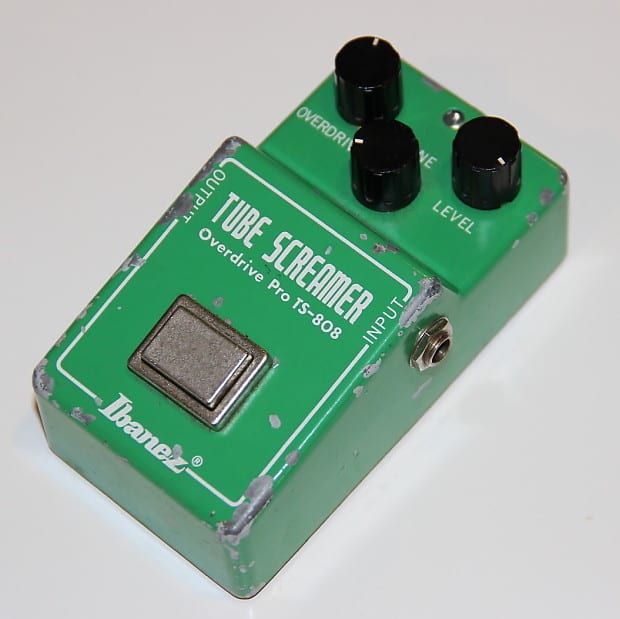
It is safe to say that the first effects pedal most guitarists buy is an overdrive or distortion pedal. Overdrive and distortion are so ubiquitous in contemporary guitar playing, and music in general, that it is difficult to imagine a time before the shredding, shrieking, and screaming sounds of these marvelous machines.
The history of overdrive and distortion effects is one of the greatest accidents in musical history and its discovery spawned some of the nastiest, gnarliest sounds ever produced. We take for granted the electric guitar itself is only about a century old and overdrive as a standalone guitar effect only began to emerge in the early 1960s.
As with most paradigm-shifting, creative innovations, there are some conflicting stories about the origins, influences, and dates of the overdrive effect. Part of what makes the history of effects like overdrive so interesting is the mythology that builds around them. One such legendary figure was the sonic saint Leo Fender.
In 1947, Fender designed a breakthrough guitar amplifier called the Super Amp. While it may not seem like much compared to today’s behemoth rigs, the first Fender Super Amp clocked in at a whopping 18 watts. But, compared to the 10 watt Electro String amplifier that was in standard production, the Fender Super was nothing short of groundbreaking. Additionally, electric guitarists soon discovered a special feature of this new device: when the amplifier was cranked, it produced a fuzzy, distorted tone.
This dirty, gritty tone created by cranking the amp to its limit inspired a generation of sonic experimentation in lock-step with the developments in rock and roll, blues, and eventually heavy metal music. From intentionally dropping amplifiers, to purposefully cutting or puncturing speakers, guitarists of the time were hungry for a more raw and powerful sound.
The overdrive effect’s commercial breakthrough came in 1965 courtesy of the Rolling Stones. Guitarist Keith Richards was toying around in the studio with Gibson’s Maestro FZ-1 Fuzz Tone pedal. The Maestro FZ-1 is probably the first “stompbox” style effect, but despite the increasing desire for distorted guitar tones, the FZ-1 did not catch on right away. That is, until Richards demoed the main riff of “(I Can’t Get No) Satisfaction” with that nasty Maestro Fuzz Tone. And thus, the era of stompbox distortion pedals was born!
The “modern” era of overdrive pedals really kicked off in the 1970’s. Companies like Boss, Maxon/Ibanez, and MXR began producing compact overdrive and distortion stompbox pedals. These pedals remain widely popular and a standard item in every guitarist’s pedalboard.
The Boss OD-1 debuted in 1977. The OD-1 produces an asymmetrical clipping effect, which creates an edgier distorted tone. On the theoretical side, asymmetrical or symmetrical clipping refers to the manner in which the amplitude peaks of a waveform are clipped. If a circuit clips asymmetrically, it means that the waveform’s peaks and valleys are clipped unevenly. Conversely, if a circuit clips symmetrically, the waveform is clipped evenly. Asymmetrical clipping is generally regarded as a more aggressive and edgier tone, while symmetrical clipping is generally considered a smoother and warmer sound. Asymmetrical clipping is more similar to the clipping produced by tube amplifiers, making the OD-1 the perfect choice for guitarists looking for that classic overdrive tube sound, without having to crank up the amp to 11.
The Boss OD-1 is remarkably simple in its setup. With just two knobs, the left controlling the output level and the right controlling the amount of overdrive, the OD-1 essentially laid the foundation for the concept of “overdrive” in the lexicon of guitarists everywhere.
Initially inspired to create a pedal that could compete with the Boss OD-1, Ibanez debuted the Maxon-built TS-808 TubeScreamer pedal in 1979. Likewise, the layout of the TS-808 is elegantly straightforward, a small, green box with a compact silver switch and three knobs: overdrive, tone, and level. The original TS-808 featured an almost identical circuit to the OD-1, with the exception of one innovative detail.
Instead of asymmetrically clipping the waveform (and in order to circumvent patents on the OD-1), the brilliant engineers at Maxon/Ibanez designed the TS-808 to clip symmetrically. By placing an even number of diodes on the positive and negative ends of the clipping circuit, Ibanez produced a pedal with a warm, smooth, and rounded overdrive tone. This design innovation inspired the warped scream of Iridium FX’s Asterius Overdrive. Boutique pedal builders have made a number of creative innovations to this design. The Asterius Overdrive from Iridium FX incorporates a pair of red LEDs, rather than silicon or germanium diodes for clipping.
As pedal technology progressed and guitarists began to find new, creative ways to use these monsters of musical mayhem. Many pedals have emerged since, including Boss updates OD-2 and OD-3, Ibanez’s TS9 and TS10, the MXR Distortion+, and the Klon Centaur, in addition to a host of boutique and imaginative designs from circuit benders around the world.